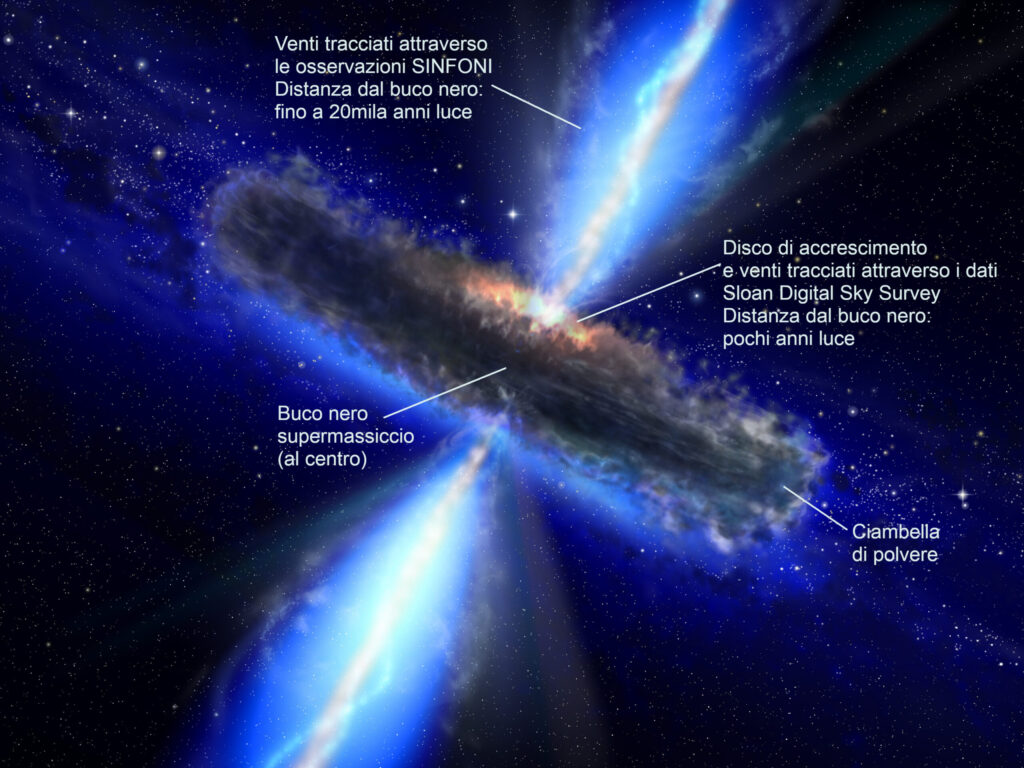By studying a sample of distant galaxies, whose light comes to us from an era when the Universe was only three billion years old, a team of researchers led by Giustina Vietri of the National Institute of Astrophysics has followed the winds that rage in the “Active” galaxies up to a few light years from the supermassive black holes that populate in the galactic centers. The new study shows how these winds, which travel at speeds of millions of kilometers per hour, can affect interstellar gas on scales of tens of thousands of light years.
Most supermassive black holes that lurk in galaxies, such as the one at the center of our Milky Way, are completely harmless and at most swallow some star or cloud of gas that dares to get too close. A small percentage, however, is in great turmoil, devouring the surrounding matter at conspicuous rates through an accretion disk that heats up and gives rise to intense emissions across the entire electromagnetic spectrum. These signals allow us to recognize the “active” galaxies when observing the sky, ie those galaxies that host black holes in a phase of turmoil.
But not even the most “voracious” black holes are able to engulf all the material that surrounds them, triggering gigantic winds that throw away some of the material and that can propagate on galactic scales. For years, astrophysicists have been debating the importance of these winds and their possible effects on the evolution of host galaxies through action-and-reaction (or feedback) mechanisms that would have the ability to regulate both the growth of the central black hole and the formation of new stars.

“This is a topic of considerable importance for the understanding of how the Universe has evolved”, comments Giustina Vietri of the INAF in Milan, the first author of a new work that analyzes, for the first time using a representative sample of active galaxies, the effect of these winds on different scales within the galaxies. “In this study we have tried to shed light on one of the problems currently most discussed: the link between the supermassive central black hole and its host galaxy.”
The results of the study, published in the journal Astronomy & Astrophysics, are part of the Super (A Sinfoni Survey for Unveiling the Physics and Effect of Radiative feedback) project which has already produced two other publications signed by the same research team. The project was born with the aim of studying gas leakage from galactic centers using the Sinfoni instrument mounted on ESO’s Very Large Telescope in Chile.
“Sinfoni is an integral field spectrograph that operates in the near infrared and uses adaptive optics to obtain high-resolution spectra of extended sources,” says Vincenzo Mainieri of ESO, principal investigator of the Super project and co-author of this new study. “Therefore, compared to the instruments previously used to make spectroscopic surveys of active galaxies, Sinfoni allows the spatial resolution of the gas”.
Thanks to the data collected with Sinfoni, the team examined a representative sample of 21 active galaxies, studying the link between black holes and their host galaxies, for the first time, in a systematic way, i.e. without selecting the galaxies for which they already have indications of the presence of winds. The observations revealed galactic winds in all the sources examined, showing that these phenomena are very common in the phase of cosmic history to which these galaxies belong, in which the universe – which today is 13.8 billion years old – had a age of only 3 billion years.
“These winds, which travel at speeds between 3 and 7 million km / h, extend up to twenty thousand light years from the centers of host galaxies,” adds Michele Perna of INAF of Florence and Centro de Astrobiología of Madrid, co-author of the article.
Using an astronomical “microscope”, or by analyzing the optical spectra of these galaxies available in astronomical archives, the researchers then followed the winds to the source, near the gigantic black holes.
“The lines emitted by ionized carbon atoms, visible in the spectra of the Sloan Digital Sky Survey, are generated a few light years from the black hole, and reveal how the winds of ionized material discovered with Sinfoni are also present on these relatively small scales, in the heart of the galaxies», explains Vietri. “So we were able to connect, for the first time, the presence of galactic winds from the smallest to the largest scales.”
The results show that winds observed at small distances strongly depend on the properties of the central black hole – such as the growth rate or the brightness of the galactic core, produced by the activity of the black hole. These winds would also have the ability to influence the gas up to the borders of their respective galaxies. In the future, researchers will try to plot winds on even larger scales, to continue studying the influence that supermassive black holes can, in this way, have on the evolution of galaxies.
This work was published in the scientific journal Astronomy & Astrophysics with the title: “SUPER III. Broad Line Region properties of AGN at z∼2”, by G. Vietri, V. Mainieri, D. Kakkad, H. Netzer, M. Perna, C. Circosta, CM Harrison, L. Zappacosta, B. Husemann, P. Padovani, M. Bischetti, A. Bongiorno, M. Brusa, S. Carniani, C. Cicone, A. Comastri, G. Cresci, C. Feruglio, F. Fiore, G. Lanzuisi, F. Mannucci, A. Marconi, E. Piconcelli, A. Puglisi, M. Saved, M. Schramm, A. Schulze, J. Scholtz, C. Vignali and G. Zamorani.
Original post: www.media.inaf.it
